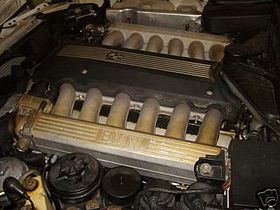BMW M70
| BMW M70 engine | |
|---|---|
 |
|
| Overview | |
| Manufacturer | BMW |
| Production | 1987–1996 |
| Combustion chamber | |
| Configuration | 60° V12 |
| Chronology | |
| Predecessor | None |
| Successor | BMW M73 |
The BMW M70 is a V12 SOHC piston engine which was BMW's first production V12 and was produced from 1987 to 1996.
The M70 essentially acts as two 2.5L straight-6 engines joined at a 60 degree angle, and shares many design elements from BMW's earlier SOHC engine designs, most notably the M20. The M70 was machined on the same tools as the M40 straight-4 engine, and shares some common parts. Additionally, it carries over the same 84mm bore and bore spacing, 75mm crankshaft stroke and six cylinder bank(s) of the 2.5 litre M20. The M70 has two Motronic 1.7 ECUs (one for each cylinder bank).
This said, the M70 engine does differ from earlier designs in a number of key ways, including:
Some examples of this engine are fitted with two alternators, such as in the E32 750iL Highline. One alternator is a full sized unit to service the car as on "regular" V12 models (regular to be taken in context of course), while the secondary smaller unit is used to charge an auxiliary battery and power all options in the rear passenger compartment, such as telephones and fax machines, as well as the wine cooler, independent climate control and power sun shields.
The compression ratio is 8.8:1, stroke is 75 mm (3.0 in) and bore is 84 mm (3.3 in).
Applications:
This is a 5,576 cc (340 cu in) variant of the M70 engine fitted only to the E31 850CSi. With 1,510 units produced, this is the lowest production BMW engine to date.
Applications:
The S70/2, while sharing the same 12 cylinder layout and design principle as the S70B56, is essentially two European market S50s joined together, and thus features 4 valves per cylinder and variable valve timing (called dual-VANOS by BMW). Unlike the M70, it does not have hydraulic valve lifters, and as such requires routine valve adjustment.
Applications:
...
Wikipedia
